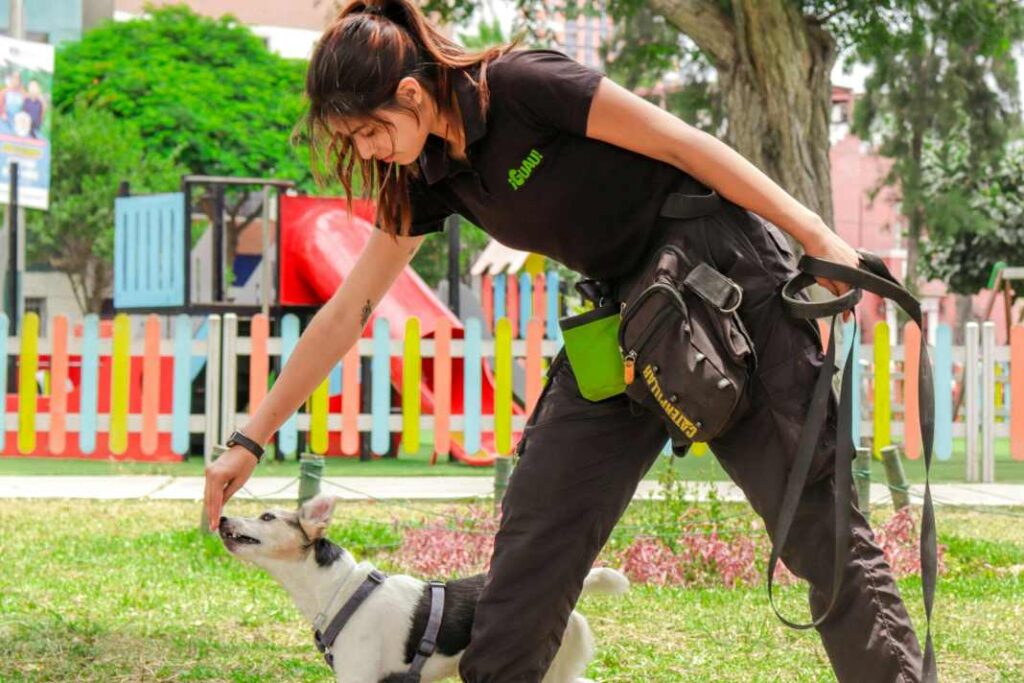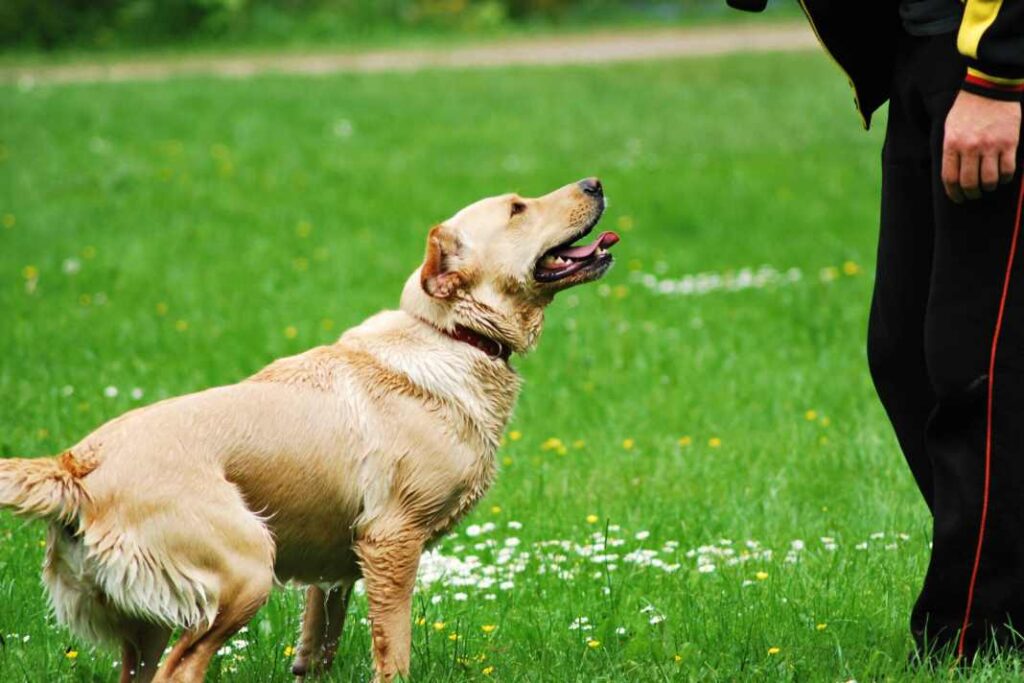Addressing Resource Guarding in Dogs: Learn how to recognize the signs, use positive reinforcement training techniques, seek professional guidance, and implement preventive measures to address and manage resource guarding behavior in dogs effectively.
Introduction to Resource Guarding Behavior in Dogs
Resource guarding is a behavior exhibited by dogs when they perceive a threat to their valued resources, such as food, toys, sleeping areas, or even a human companion. This behavior can manifest in various forms, including growling, stiffening, lunging, or biting.
It stems from their instinctual need to survive, developed from their ancestors in the wild, which drives them to protect their possessions from perceived threats. Understanding the underlying reasons for resource-guarding behavior is crucial in effectively addressing and modifying this behavior.
For instance, a dog might stiffen and growl when someone approaches while it’s eating. This behavior is not limited to food and toys; dogs may also guard spaces or people.
Recognizing these signs early and understanding their root in survival instincts can help in developing strategies to manage and modify such behaviors in our canine companions.
Click here for Expert Videos to Stop Dog Behavioral Problems!
Recognizing the Signs of Resource Guarding in Dogs
Resource guarding can be identified through various signs, including but not limited to growling, baring teeth, freezing, raised fur, or a tense body posture. These signs may escalate to more intense behaviors, such as snapping or biting if not properly addressed.
It’s also important to note that dogs may exhibit resource guarding towards tangible items like food or toys and spaces or people they perceive as valuable.
A classic example of this behavior could involve a dog that growls and snaps when another pet in the house gets too close to its bed. This indicates the dog’s attempt to protect a valued space, not just food or toys.
Recognizing these signs early is key to preventing escalation and ensuring the safety of all household members, both human and animal.

The Role of Positive Reinforcement in Addressing Resource Guarding in Dogs
Positive reinforcement plays a significant role in addressing resource guarding in dogs. This training method focuses on rewarding desired behaviors and encouraging the dog to exhibit those behaviors more frequently.
By using positive reinforcement, dogs can learn that relinquishing a guarded resource can lead to receiving something even more valuable, thus helping to modify their guarding behavior.
For example, if a dog shows non-guarding behavior by allowing someone to approach while it’s eating without displaying aggression, immediately rewarding this behavior with a high-value treat reinforces the idea that non-guarding behavior is more beneficial.
This method helps change the dog’s perception of threats to their resources and strengthens the bond between the dog and its owner through trust and positive experiences.
Effective Training Techniques for Addressing Resource Guarding
Counter conditioning and redirection are effective training techniques for addressing resource guarding in dogs. Counter conditioning involves changing the dog’s emotional response to a trigger by associating it with something positive.
For example, if a dog guards its food, feeding it treats by hand while it’s eating can help change its association with someone approaching its food bowl from negative to positive.
Redirecting a dog’s focus from the guarded resource to an alternative behavior or command can also be effective. For instance, teaching a dog to “leave it” or to come to you when called instead of guarding a toy or food can help modify its behavior over time.
Consistency and repetition in these training sessions are crucial in reinforcing new, positive behaviors and gradually altering the dog’s response to triggers related to resource guarding.

Seeking Professional Guidance in Addressing Resource Guarding
When resource guarding behavior escalates or if an owner feels unsure about addressing it alone, seeking professional guidance becomes crucial. Professional trainers or behaviorists can assess the situation and develop a tailored behavior modification plan. Additionally, consulting with a veterinarian can help rule out any medical issues that may contribute to the behavior.
In severe cases, such as when there’s a risk of biting, professional intervention is essential to ensure the safety of all involved. For example, a behaviorist can observe the dog’s behavior in various contexts and provide specific strategies and training programs tailored to the dog’s needs.
Preventive Measures and Long-Term Strategies for Managing Resource Guarding
Preventing resource guarding in dogs involves implementing management strategies and teaching key skills. Controlling access to valuable resources, using crate training to manage space, and incorporating regular training sessions to teach commands like “Drop It” and “Leave It” are effective strategies. These measures, along with providing mental stimulation through enrichment activities, can help mitigate the likelihood of resource guarding behaviors.
Long-term management may involve ongoing training, environmental modifications, and consistent reinforcement of desired behaviors. For instance, ensuring that a dog has a positive association with someone approaching it while it’s eating or playing with a toy by regularly practicing desensitization and counter conditioning exercises can help maintain progress and prevent relapses.
The Influence of Genetics, Stress, and Medical Factors on Resource Guarding Behavior
Genetics, stress, and underlying medical conditions can all influence the development and severity of resource guarding behavior. Some breeds may be more predisposed to exhibit resource guarding due to their genetic makeup. Additionally, stressors in a dog’s environment or unresolved medical issues can exacerbate this behavior.
Addressing environmental stressors and ensuring the dog’s physical and emotional well-being are crucial in managing and reducing resource guarding behavior. Regular veterinary check-ups can help identify and treat any medical conditions that may be contributing to the behavior while creating a stable and secure environment that can reduce stress-related triggers.
Exploring the Terminology Debate: Resource Guarding vs. Possessive Aggression
The terms “resource guarding” and “possessive aggression” are often used interchangeably, but they encompass different scopes of behavior. Resource guarding in dogs is a broader term that includes various behavior patterns in dogs dogs exhibit to control access to valuable items, while possessive aggression specifically focuses on aggressive behaviors.
Understanding these distinctions is important for effective communication among dog owners, trainers, and behaviorists. It ensures that interventions are accurately tailored to address the specific manifestations of guarding behavior. This nuanced understanding of terminology underscores the importance of clear communication and consistent definitions in the field of canine behavior research and training.
Mastering the Basics: A Guide to Basic Obedience Training for Dogs

Basic obedience training is more than just a series of sessions; it’s a continuous part of your life with your dog. Incorporate commands into daily routines, like asking your dog to sit before meals or stay before crossing the street. The more you integrate training into everyday life, the stronger your bond and communication will be.
Continue reading: A Guide to Basic Obedience Training for Dogs




